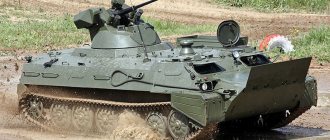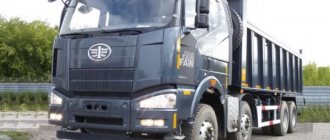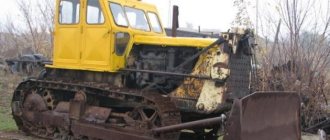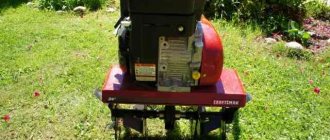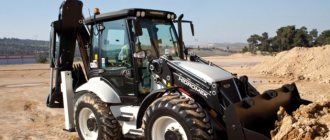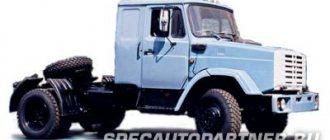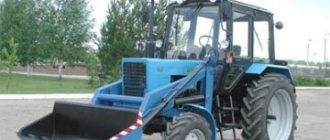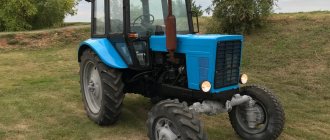American barrel
Pavel Gamankov, photo by the author
| Manufacturer: | Kenworth |
| Chassis model: | T-800 |
| Superstructure Manufacturer: | CBMW |
| Price: | 33,469 euros |
I’m tempted to write “America gave a steamship to Russia. Two pipes, rear wheels and terribly quiet running.” Imported trucks with original concrete mixing drums are rarely supplied to Russia. With the exception of the ubiquitous “Chinese”, we receive bare chassis on which Russian-made superstructures are installed. There are also curious exceptions - at the Dmitrovsky training ground NITSIAMT NAMI is just undergoing certification tests of a Kenworth T-800 series bonneted truck with an American CBMW mixer.
The first thing that attracts attention about the Kenworth T-800 is its narrow cabin. For a truck from the United States, this is a common occurrence (remember: trucks in size groups IV–VIII from International, Chevrolet, GMC, Ford, Chrysler, De Soto and Dodge were generally equipped with cabs from full-size pickups until the 2000s).
Our concrete mixer has a 2-seater cabin without a berth, which makes the machine look a little awkward in appearance. Otherwise, the Kenworth T-800 is a typical “American”: the massive hood and front wheel arches are made of plastic to facilitate access to the power unit. The fuel tank is hidden behind the running boards on the passenger side; on the driver's side, under the steps, there is a box for four parallel 12-volt batteries.
The truck's superstructure looks quite familiar and, except for a small inscription on the side, does not betray its American origin. By the way, it is actually partly European - some components are manufactured by ZF. The huge 150-gallon water tank suggests that this vehicle is designed not only for transportation, but also for making mixtures if necessary. It is interesting that when crossing the border of the Russian Federation, vehicles for transporting concrete and machines for preparing mixtures are cleared through customs according to different coefficients and classified as vehicles for various purposes.
On my way
As I expected, the cabin of the “American” is a bit cramped, like in the cabin of a GAZ-3307 or ZIL-130. But, unlike them, the cabin turned out to be double in the full sense of the word. There would not be room for a third passenger between the driver’s and partner’s seats, even with the best will (I can’t even imagine why some manufacturers produce concrete mixers with three seats and a “sleeping bag”). There is also not much space for travel luggage. At the same time, you can sit comfortably behind the wheel. The air-suspended seat is adjustable over a wide range, and the steering column has reach and tilt adjustments. In the basic configuration, the air-suspended seat is installed only for the driver, the passenger seat is mounted on rigid supports. This is a severe test for a fellow traveler, because the truck cabin does not have its own suspension and is tightly fixed to the frame. So you won’t envy the passenger on a country road. At least somehow the situation is saved by the heavy dead weight of the concrete mixer truck and soft road tires. Although such “shoes” are not always suitable for a car working on construction sites.
At first glance, the instrument panel is overloaded with information - the huge number of sensors and keys is confusing. But thanks to well-thought-out ergonomics, you master them quickly - third-rate sensors are brought to the periphery of vision. The secondary ones are located right next to the speedometer and tachometer. Control over the condition of the main systems of the car, as in a Soviet diesel locomotive, is entrusted not to the electronics, but to the driver. The panel has sensors for battery charging, oil and coolant temperature, pressure in the pneumatic system circuits, etc. To turn on the mixing drum, a separate control unit is provided, located between the seats. And even a baby can handle it - to turn on the drive, just move the lever to the load position and it’s done, there’s no need to even press the clutch pedal or turn on the PTO. To stop the drum, move the lever to the neutral position. It couldn't be simpler!
Some nice touches include powerful air conditioning, cruise control and an engine brake. Using separate keys, you can increase / decrease the speed when driving with cruise control turned on, as well as increase / decrease the power of the engine brake when descending a mountain.
The visibility from the driver's seat is surprisingly good; the massive hood is licked from the front and does not cause any inconvenience when driving the car. The rear view mirrors are widely spaced, heated and provide good visibility to the rear. Although additional mirrors on the hood would be nice.
Cooking "porridge"
The test truck is equipped with a Caterpillar C-12 power unit with 380 hp. Not to say that the numbers are impressive, but there is no doubt about the talents of the American engine. At idle the engine is noisy, but the sound is immediately recognizable as a tractor! In the good sense of the word. Most tractors are equipped with engines with a mechanical in-line injection pump. Although this design is noisy, a design more reliable than an in-line mechanical pump has not yet been invented. But for domestic consumers, the reliability of equipment is often at the forefront, and the similarity of an American “mixer” with a domestic tractor in this case is a compliment.
The Kenworth's cabin is well soundproofed, and when driving, the rumble of the diesel engine is not annoying, nor are other aerodynamic noises. The turbocharger is active in almost the entire engine speed range and starts already at 800–900 crankshaft revolutions. Despite the fact that the power unit keeps idle at around 600 rpm, the whistle of the turbine can be heard almost immediately after pressing the gas pedal. The engine spins briskly up to 1500–1600 rpm, and this is where it’s time to upshift. An unsynchronized gearbox will shift smoothly and gently at exactly these speeds. So it makes no sense to rev the engine to a maximum of 2000 rpm; during such shifts, you can hear a slight crunch in the gearbox, even when operating the clutch twice. And this, I must say, is not so simple. Another characteristic feature of American trucks is tight pedals, in particular the clutch pedal. Apparently, the Kenworth T800 uses the most reliable and archaic scheme, without pneumatic booster. The fire of negative emotions of such a dense solution is extinguished by the weak hope of indestructibility, especially since the pedals, although tight, are informative.
A few more words about the 10-speed Eaton Fuller gearbox without synchronizers. When upshifting, the clutch pedal is depressed halfway. The only exception is at the start, here we depress the pedal completely. By the way, an empty truck starts without problems in the upper range immediately in VI gear, so the driver will have to operate the flag only when partially or fully loaded. When downshifting, it is recommended to slightly shift the throttle in neutral. This may sound scary and suspicious, but in fact, working with KP is a pleasure. These are not Chinese transmissions without synchronizers, in the description of which the words “almost”, “quite satisfactory” and “after running-in” often had to be used. The American Eaton Fuller is deprived of synchronizers not to simplify or reduce the cost of the design, but for the sake of the same notorious reliability.
A standard complaint about the steering of American trucks is a large turning radius. The Kenworth T-800 was no exception. Otherwise, there are no complaints about the management. Powerful hydraulic booster, clear feedback. Irregularities in the road surface are practically not transmitted to the steering wheel.
Features of operation
The test Kenworth T-800 was clearly prepared specifically for Russia; it is of the so-called northern version. This is not difficult to determine. Firstly, the car is equipped with a winter fuel intake with a fuel heating system. secondly, the engine is equipped with a system for heating the engine oil during parking. A special socket is located under the driver's door, so turning on the heating will take a matter of seconds. But the heating of the water tank provided for preparing the concrete mixture is not installed. But the tank itself is made in the form of an isotherm and has several layers of insulating material, so that even in severe frosts the water will not freeze for a long time. Although, at temperatures below –20°C, it is unlikely that anyone will decide to check the thermal insulation properties of materials and pour water into the tank unless absolutely necessary.
By the way, on an American concrete mixer, the drum drive was made in Germany, at ZF, as evidenced by the corresponding plate. The mixing drum drive itself is also interestingly designed. The container is driven by a power take-off connected to the main engine of the truck. Moreover, the PTO is rigidly connected to the power unit and works constantly, even if the mixer is turned off. A speed and rotation speed control sensor is installed on the drum drive, next to a radiator and a hydraulic fluid cooling fan.
The American truck is equipped with a central lubrication system. The single block with nipples for squirting is hidden behind the front right wheel, but access to it is quite easy.
Another example of a peculiar American approach that increases the service life of components and assemblies is the rear suspension of a truck. Instead of springs and shock absorbers, a simplified design is used here using a gasket made of a damping rubber element. Such an unusual design may cause mistrust, but we have already seen similar solutions on other American chassis. Machines with such a suspension are widespread in America and are considered most suitable for work on construction sites. The jet rods of the Kenworth T-800 are intricately twisted, which is clearly visible in the photo. But, as it turned out, this was done to unify this unit; the right and left rods in this design are interchangeable. The only “but” associated with the rear suspension of the truck is the weight characteristics of the vehicle. A sticker in the cab says the Kenworth T-800 has a factory maximum gross vehicle weight rating of 62,540 pounds, or 28.15 tons. That's not much for a three-axle truck.
Technical characteristics of Kenworth T-800
| Wheel formula | 6x4 |
| Chassis weight, kg | 8310 |
| Gross chassis weight, kg | 28 150 |
Engine:
| Caterpillar C-12 ACERT, turbodiesel, I-6, Euro 3 11 946 380 |
| Transmission | Eaton Fuller FR0-1621 OC, mechanical |
| Number of forward/reverse gears | 10/ 2 |
| Tires | 315/80 R22.5 |
And the devil woke up: test drive Kenworth T800
Fuel consumption is about 30-35 liters of diesel fuel per 100 kilometers, so taking into account two tanks of 375 liters each, the T800’s cruising range is about 2,000 kilometers. The figure, of course, is approximate, because it greatly depends on operating conditions: on the highway, consumption will be much less than in the city. The car was not started during the New Year holidays, but the engine started successfully, which indicates its good condition. After 2003, the engine was equipped with an exhaust gas recirculation system, but our car, of course, does not have this thing.
By replacing some hardware, this unit can produce one and a half times more “horses” than after only software intervention. What sets it apart is Detroit's impressive resource base. Of course, only with proper care of the unit.
The transmission is a ten-speed Eaton Fuller. What's interesting about it? First of all, there is a lack of synchronizers in the usual sense of the word. Truck drivers in America are taught the technique of double clutch release - they know what double clutch and float are. The first is a double release, and the second is a method of shifting without squeezing the clutch at all. To do this, a clutch brake is installed at the gearbox. Americans, there is nothing more to say.
Motors have a lot of crap, so the designers tried to protect the transmission from “breaking” the axles (ruining the gearboxes, in other words). Therefore, when excessive fanaticism is applied to the gas pedal, cardan crosspieces are more likely to break: changing them is easier and cheaper than gearboxes or gearboxes.
The brake system is pneumatic, drum brakes. There is nothing unusual here. The pads, of course, are “expandable”: until the pressure is built up, you won’t be able to compress them and release the brakes.
While there is nothing unusual in the front suspension (there are double-leaf springs), the rear suspension is of interest: it has eight air springs (usually there are four). This solution makes it possible to load the rear platform very well, which made it possible for these “Caches” to tow a hundred-ton mobile asphalt plant (it turns out there are such things). Moreover, it not only withstands such weight without problems, but also rushes it at a speed of one hundred kilometers per hour. Not everyone is capable of this! Well, enough words. It's time to get in the cockpit and ride.
Devil under the hood
There is an opinion that the cabin of an American truck is something very spacious, cozy, damn attractive and stunning. There is, of course, some truth. It’s much more interesting here than in domestic and European soulless stampings. There is also a lot of space, but I didn’t notice anything frankly fantastic. Except, perhaps, for the dashboard, which rips out the interior of a light American aircraft from the seventies from the subconscious. I’ll be honest: I haven’t sat on such a plane, but most likely it looks the same inside. The panel in the T800 is aluminum, but covered with wood. A toggle switch can kill a person, but there is enough chrome for a couple of bumpers for a GAZ-21. But all this is not kitsch or the rampage of a madman, it is at least unusual.
Prepared mixture
To call the American mixer good or bad would be wrong. The car is certainly unique and in many ways unusual for domestic consumers. But it is not without certain advantages - such as a powerful power unit and reliable transmission. The overall simplicity of the design is also captivating. The car complies with the Euro 3 environmental standard, but unlike its European counterparts, it is practically devoid of sophisticated electronics, which in Russian conditions is an invaluable advantage.
Car provided
Kenworth T800 Specifications
Power unit:
- Cummins (Cummins) Euro ISX - 15 liters (power from 300 to 600 horsepower);
- Caterpillar - 16 l (430-500 hp);
- Westport - 15 l (400-450 hp).
Chassis:
- Maximum axle load – 10 t (front), 9.5 t (rear single), 32 t (triple axle);
- Wheel equipment – 4*2, 6*4, 6*6, 6*8, 8*4;
- Suspension - front and rear spring type.
Checkpoint:
- Fuller 13A – 13-speed manual;
- Fuller – mechanical (from 9 to 18 steps);
- Allison - automatic (5-7 speeds).
Other characteristics of the Kenworth T800:
- Braking system – drum type with ABS;
- Car weight – from 15 to 30 tons;
- Various modifications of the hood and chassis;
- Cabin - day or with sleeping bags: Studio Aero (2, 18 m), Aerocab (1.83 m), Modular (1.52 m);
- Toxicity standard – Euro 3.
The new fuel unit allows the truck to operate within a power range of up to 410-460 horsepower.
Kenworth T800 - reviews
Despite the fact that the model in question is rarely used on domestic roads, it has pleased many drivers with its reliability and comfort. The greatest delight was caused by convenient controls, interior equipment and stable power. Below are some impressions and reviews from Kenworth T800 owners and drivers:
- Alexey from St. Petersburg: “Immediately after the purchase, I was concerned about the high fuel consumption. I thought it was a matter of firmware, which came from the manufacturer. I contacted many diagnosticians and electronics engineers who assured me that they could easily cope with the problem. However, after the next programming, the car either did not want to go uphill, or, on the contrary, gained gas at a jet pace. It turned out that the problem was in the firmware of the 77 injector, produced from a 515-horsepower car with a 76. I have a 430 engine, therefore, it was not possible to push the excess fuel evenly. You just had to pay attention to the valve cover, where all the information is written.”
- Anatoly from Chelyabinsk: “The cabin is spacious, almost an apartment on wheels with two sleeping places. At speeds over 80 km/h, the car moves confidently and smoothly. Maintenance is comparable to the operation of other foreign tractors. Tires wear out after a year of active use, regardless of their cost to the manufacturer. Overall, the Kenworth T800 leaves a positive impression.”
